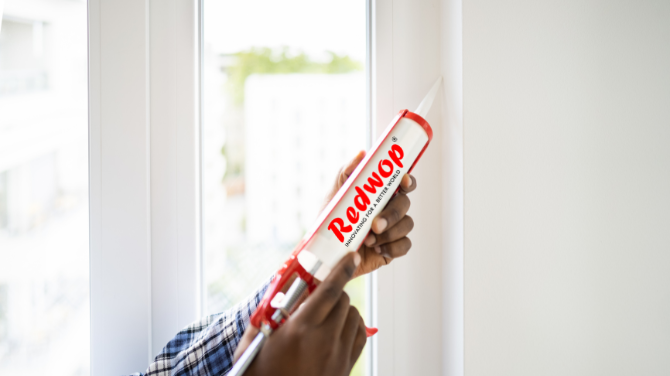Building a home requires a lot of different materials all fastened to each other. Materials like concrete, wood, metal, glass, fiberglass, and others all have their place and use in a structure. However, the joints at which these different materials might meet are tough to seal, as dissimilar materials don’t always form the tightest bonds.
What is a sealant?
Sealants are substances used to seal, block, or close gaps between building materials to prevent fluids, air, and pests from passing through. These materials seal joints where dissimilar materials meet, filling any irregularities that might exist between the two surfaces. Sealants can also fill cracks in surfaces such as concrete, fiberglass, and other rigid building materials.
Sealants typically come in thick liquids or pastes, and they can be squeezed into place with a caulking gun. Users can also apply sealants with a trowel, or apply the liquid to the joint before assembly, allowing the sealant to take the form of the gap naturally under pressure.
Sealants can also simply dress up gaps around window and door trim, or provide flexible adhesion between two surfaces. Since they prevent air and other substances from passing through gaps, they can keep a home more comfortable in various types of weather.
Joint Sealants Are an Integral Component of a Construction Project
Sealing of structural expansion joints is not just a matter of filling the gaps. Joint Sealants need to be applied and used properly to ensure that the building’s structure is protected against damage caused by surface tension and air pressure fluctuations.
Joint Sealants Offer Long-term Results
Improper Joint Sealing can also result in long-term issues of draft, water ingress, and moisture issues leading to mold and affecting the building’s structural integrity.
Hiring a Joint Sealing Specialist will help you in the following ways:
- Ensure your building is sealed against water leaks and weather damage.
- Prevent cracks and gaps from developing, leading to bigger structural concerns.
- Prevent insects, bugs, and other infestations.
- Prevent the loss of heat during winter and keep the cold air from seeping out during summer months. This in turn will keep your energy costs low.
6 Common types of sealants
There is a wide variety of sealants available, and each has its pros and cons. Some sealants are ideal for a specific purpose, meaning they’ll work for one application but possibly not for another. Others might be more general-purpose-oriented. For this reason, it’s important to choose the best sealant for the particular task at hand.
Water-based sealants
Water-based sealants, also known as latex, are popular in the construction industry for sealing gaps between moldings, doors, and windows. These sealants are easy to apply and clean up, and dry relatively quickly. Water-based sealants are also paintable. However, since the sealant contains so much water, water-based sealants tend to shrink upon drying, so they’re not ideal for wet or exterior applications.
Acrylic sealants
Acrylic sealants are paintable like latex, but their sealing properties tend to be more stable and don’t shrink as much. This makes these sealants often paintable, making them useful for outdoor applications that might need color matching, such as concrete cracks, trim around exterior windows and doors, and other easily seen and weather-exposed repairs. However, understand that acrylic sealants aren’t as flexible as some other sealants, so movement over time can cause cracking.
Butyl sealants
Butyl sealants are rubber-based, and they adhere well to many different materials. They can be a bit runny and stringy, making them messy to apply. However, these sealants don’t ever actually cure like other sealants, so they tend to be very flexible, provide a long service life, and resist UV rays, moisture, and aging. They’re highly water-resistant, but they’re not very resistant to movement, meaning these sealants can tear. They also won’t accept paint well.
Polysulfide sealants
While polysulfide sealants tend to be expensive and contain more volatile organic compounds (VOCs) than other sealant types, they’re excellent in certain applications. They remain extremely flexible throughout their service life, and they can even be applied underwater, making them an excellent choice for active leaks that need immediate repairs. Those repairs won’t be temporary, either—some polysulfide sealants last up to 20 years. Just keep in mind that most polysulfide sealants do not accept paint well.
Silicone sealants
With the exception of being unpaintable, silicone sealants are an excellent all-around sealant choice. These products remain very flexible and are highly water-resistant. They’re also less prone to shrinking than most other sealants, and they stick to almost any material. The main downside to these sealants is that they’re expensive, but they’re some of the most useful for creating water and air barriers.
Polyurethane sealants
For a tough sealant that adheres to nearly everything, a polyurethane-based sealant could be the best bet. These sealants create strong bonds between materials and seal joints to prevent fluids and other substances from passing through. They’re also abrasion resistant and provide more flexibility than many other sealant types, making them a favorite in the construction industry. Polyurethane sealants are rarely paintable, but they often come in tinted hues like gray, black, or white for matching with concrete and trim.
Conclusion
No matter the application, choosing the best sealant for the job matters. For indoor applications that require paint, the affordability and paintability of a water-based sealant are ideal. For strong and flexible bonds, polyurethane might be the way to go. It depends on the situation, but rest assured, there’s a sealant for every application.
Redwop is a sought-after sealants manufacturer and exporter in the country. The esteemed supplier of sealants in India is known for offering a whole gamut of sealants. We have been around for a while and you are spoilt for choices when it comes to quality sealants at your disposal.

